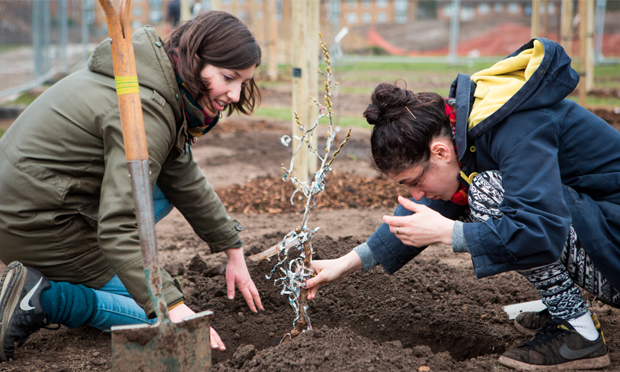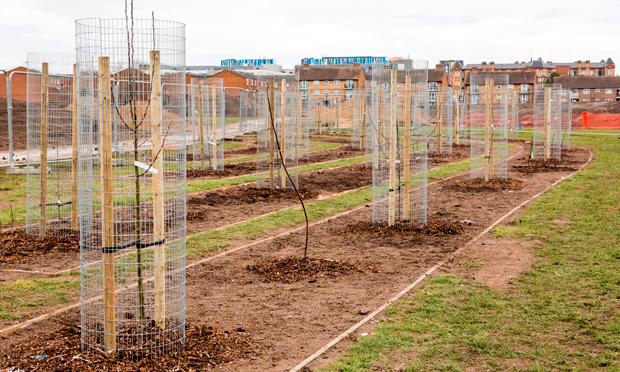Fruit tree planters plan to transform Mabley Green into ‘edible park’

Green fingers: budding planters get acquainted with the soil
Around 50 spade-wielding volunteers planted fruit trees on Mabley Green last week as part of a project to create Britain’s biggest ‘edible park’ in East London.
The volunteers gathered on Saturday 19 March to plant 30 different species of tree, in the first step of plans to transform a vast open space into a park of fruit-bearing trees, complete with shrubs, insect-attracting plants and rolling hills – surrounded by 500 extra trees to shield the park from the elements.
Organisers argue the edible park will have huge health, social and environmental benefits – as well as providing free fruit for all.
“We wanted to create a green space that gives something back socially and environmentally,” said Damian Rafferty, leader of the edible park project.
Mr Rafferty explained that having limited access to a garden or outside space can make people feel isolated.
“Community orchards are all about bringing people together to create green spaces for everyone to enjoy and build healthier, happier and more sustainable communities,” he said.
“I think it should be a basic human right that children can find and pick fresh fruit to eat.”

Trees are good: edible park saplings
During the Second World War, the Marshes were used to detonate unexploded bombs, and rubble from the Blitz was dumped on green spaces, resulting in lead contamination in the soil from the paint used on houses back then.
The council removed the contaminated soil and dug trenches to fill with ‘healthy’ soil for the initial planting.
Ioseb Soso Chakvetadze, new chair of Mabley Green Users Group, describes the space as a “vast open space mostly underused as it quite windy and noisy”.
“When plans came from the council about creating mounds for tree planting we got very excited as it would give this huge space some ‘cosiness’ and the chance for more creativity and variety,” she said.
“We want to make this space personal to everyone, offering people the chance to take part in its development and watch it grow, as well as offering all the benefits of the fruit produced and encouraging wildlife.”
The park is supported by the Helping Britain Blossom group, a coalition between beer brand Heineken and charities the Urban Orchard Project and the Bulmer Foundation.
Ryan O’Kane, Helping Britain Blossom’s project manager for London, said: “Mabley Green is a fantastic example of the huge range of benefits a community orchard can offer: from learning new skills including horticulture and cooking as well as knowledge of where our food comes from, to encouraging volunteering, bringing people together from different backgrounds, and creating wonderful social spaces that improve our health and wellbeing. Plus there’s the added benefit of free fruit for the whole community of course.
The group aims to create and restore over 100 community orchards across Britain by 2017.
Anyone interested in finding out more about the Mabley Green edible park can go to mableygreen.org, facebook.com/mableygreen or follow @mableygreener on twitter.

Hopefully arrangements have been organised to regularly water these new trees during their vulnerable first few years in the ground.
Year after year we see far too many dead or unhealthy new trees, planted with initial good intentions, but entirely lacking any aftercare.